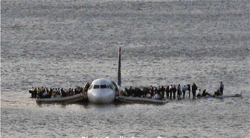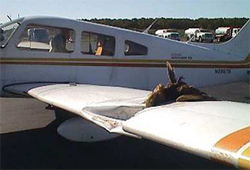An Overview
The Bird Strike Committee USA (BSC USA) provided this information.
| A wildlife strike occurs when an aircraft and an animal collide or when wildlife has a negative effect on flight. Bird strikes are not a new phenomenon. The first documented bird strike occurred in 1905, when Orville Wright flew over a corn field near Dayton, Ohio.
The FAA estimates that birds and other wildlife cause over $500 million in damage to US civil aviation annually. These strikes can put the lives of crew members and passengers at risk.
|

|
The FAA’s National Wildlife Strike Database
Since 1990, the Federal Aviation Administration (FAA) has maintained a National Wildlife Strike Database (NWSD). Strike reporting has increased substantially since 2009. From January 1990 to June 2016, more than 177,000 wildlife strikes with civilian aircraft were recorded in the database. Of these, 229 strikes resulted in a total of 400 injuries to humans. Twelve strikes resulted in a total of 26 fatalities. Visit the
NWSD website.
Strike reporting is mandated for all Air Traffic Controllers and voluntary for the remainder of the industry. Most experts agree that the database captures the big picture and ongoing trends.
- The number of bird strikes reported annually continues to rise. That may be due in part to better reporting practices.
- Damaging strikes on airports, where most strikes occur, show signs of decline.
- Damaging strikes with small aircraft are a growing concern.
Wildlife Strikes are Unusual – Damaging Strikes are Rare!
It’s important to remember that despite these numbers, wildlife strikes are relatively unusual events. Strikes that result in aircraft damage or injuries are rare! Of the approximately 24.5 million commercial aircraft movements that occurred in 2015, damaging wildlife strikes occurred at a rate of less than 1.4 damaging wildlife strikes/100,000 movements. Substantially damaging strikes occurred at a rate of 0.3 strike/100,000 movements.
Wildlife Strikes to Commercial Aviation Aircraft in the US 2015 |
| Total Commercial Aircraft Movements in the US |
24,500,000 movements (average 67,123/day) |
| Total Strikes Reported by US Commercial Aviation |
12,250 strikes (average 34/day) |
| Strikes with Damage |
340 strikes (3% of total strikes reported) |
| Strikes with Substantial Damage (>$200,000) |
80 strikes (<1% of total strikes reported) |
Changes in Airport Wildlife Management Since 2009
The FAA has addressed wildlife hazards and wildlife hazard management since the 1960s. The Miracle on the Hudson increased the FAA’s and airport industry’s focus on this issue and raised public awareness.
Since 2009, FAA has worked to provide additional/updated guidance and contributed additional resources to wildlife management. The FAA has:
- Hired an additional wildlife biologist.
- Increased efforts to promote wildlife strike reporting.
- Funded hundreds of Wildlife Hazard Assessments and Wildlife Hazard Management Plans at commercial and general aviation airports nationwide.
In addition, airports throughout the US have worked with airport wildlife biologists to identify wildlife attractants on and off airports. They also assist with the development and implementation of wildlife hazard management programs.
Non-government Efforts
Efforts by non-government agencies have also increased. FAA entered into a Memorandum of Agreement with Bird Strike Committee USA. This includes representatives from the airline industry, airline manufacturers, and the private sector. The goals are to promote education and develop new wildlife hazard management measures. Collaboration is ongoing. |

|
FAA and BSC USA are partnered to provide educational programs to airports and pilots on the importance of wildlife strike reporting. BSC USA is providing information at national aviation events such as:
- Airshows.
- Airline Pilots Association Conference.
- North American Ornithological Conference.
BSC USA is gathering information to provide FAA with recommendations for improving the quality/quantity of wildlife strike reports sent to the National Wildlife Strike Database.
Aircraft manufacturers are continuing research to identify the effects of wildlife strikes and develop new technology to make aircraft more resilient to wildlife strikes.
Avian Radar
FAA, air traffic controllers, and pilots completed a study on avian radar and how real-time information on wildlife presence can be provided to air traffic controllers. Following four years of study, FAA developed guidance on the use of avian radar systems to supplement an airport’s Wildlife Hazard Management Plan. The guidance also covered reducing potential avian threats to aircraft (see FAA Advisory Circular 150 5200-25, Airport Avian Radar Systems).
Wildlife Hazard Management at Airports
More than 90 percent of all wildlife strikes occur at altitudes of less than 3,000 feet (typically at locations on or near airports). Airports operators are aware of wildlife hazards and consider wildlife management as part of their daily operations. Activities such as fence construction and maintenance, vegetation management, stormwater management, and staff education/awareness are ongoing at US airports to enhance safety and reduce risks. |

|
Resources
Several resources are available to help communities learn more about wildlife hazard management:
About Bird Strike Committee USA
BSC USA is a volunteer organization and national expert body whose mission is to provide leadership in managing wildlife hazards to aviation. The BSC USA has a Memorandum of Agreement with the FAA to serve as a formal cooperator/advisor and is a liaison to the FAA and other Bird Strike Committees world-wide. |

|
Their membership includes representatives from the FAA, US Department of Agriculture, Department of Defense, airports, airlines, aerospace industries, Smithsonian Institution and the private sector. BSC USA facilitates the exchange of information about aviation wildlife hazard mitigation through education and outreach. It also promotes ongoing data collection, research, as well as the development of innovative strategies/technologies. For more information or membership, visit
Bird Strike USA.
